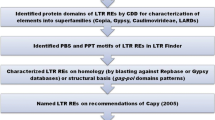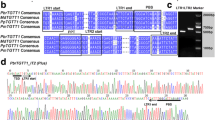Abstract
Ty1-copia retroelements have been found in all major plants and are largely responsible for the huge differences in the genome size. In this study we isolated and sequenced Ty1-copia reverse transcriptase (rt) gene fragments from 44 representative species of bamboo and nine cultivars or forms of Phyllostachys pubescens. Phylogenetic analysis of 72 distinct Ty1-copia rt sequences showed that Ty1-copia retroelements were widespread, diverse and abundant in these species of Bambusoideae subfamily. In addition, a molecular phylogeny of the species of the Bambusoideae subfamily was established by using the internal transcribed spacer sequences of nuclear ribosomal DNA (ITS) sequences. The comparison between ITS- and Ty1-copia rt- based trees is obviously incongruent. The results suggested either the existence of horizontal transfer events between phylogenetically distant species, or an ancestral Ty1-copia retroelement polymorphism followed by different evolution and stochastic losses.



Similar content being viewed by others

References
Adachi J, Hasegawa M (1996) MOLPHY: programs for molecular phylogenetics based on maximum likelihood 2.3. The Institute of Statistical Mathematics, Tokyo
Alix K, Heslop-Harrison JS (2004) The diversity of retroelements in diploid and allotetraploid Brassica species. Plant Mol Biol 54:895–909
Alix K, Ryder CR, Moore JM, King G, Heslop-Harrison JS (2005) The genomic organization of retrotransposons in Brassica oleracea. Plant Mol Biol 59:839–851
Bennetzen JL (2002) Mechanisms and rates of genome expansion and contraction in flowering plants. Genetica 115:29–36
Brosius J (1999) Genomes were forged by massive bombardments with retroelements and retrosequences. Genetica 107:209–238
Chen R, Li X, Song W, Liang G, Zhang P, Lin R, Zong W, Chen C, Fung H (2003) Chromosome atlas of major economic plants genome in China, Tomus IV: chromosome atlas of various bamboo species. Science Press, Beijing, pp 275–284
Clayton WD, Harman KT, Williamson H (2006) GrassBase, the online world grass flora. http://www.kew.org/data/grasses-db.html
Das M, Bhattacharya S, Singh P, Filgueiras TS, Pal A (2008) Bamboo taxonomy and diversity in the era of molecular markers. In: Jean-Claude K, Michel D (eds) Advances in botanical research vol 47. Academic Press, London, pp 225–268
Doyle JJ, Doyle JL (1987) A rapid DNA isolation procedure for small quantities of fresh leaf tissue. Phytochem Bull 19:11–15
Dransfield S, Widjaja EA (1995) Plant resources of South-East Asia No. 7 Bamboos. Backhuys Publishers, Leiden
Eickbush T (1994) Origin and evolutionary relationships of retroelements. In: Morse S (ed) The evolutionary biology of viruses. Raven Press, New York, pp 121–157
Ellis THN, Poyser SJ, Knox MR, Vershinin AV, Ambrose MJ (1998) Polymorphism of insertion sites of Ty1-copia class retrotransposons and its use for linkage and diversity analysis in pea. Mol Gen Genet 260:9–19
Feschotte C, Jiang N, Wessler SR (2002) Plant transposable elements: where genetics meets genomics. Nat Rev Genet 3:329–341
Flavell AJ, Smith DB, Kumar A (1992) Extreme heterogeneity of Ty1-copia group retrotransposons in plants. Mol Gen Genet 231:233–242
Flavell AJ, Pearce SR, Heslop-Harrison JS, Kumar A (1997) The evolution of Ty1-copia group retrotransposons in eukaryote genomes. Genetica 100:185–195
Fortune P, Roulin A, Panaud O (2008) Horizontal transfer of transposable elements in plants. Commun Integr Biol 1(1):74–77
Friesen N, Brandes A, Heslop-Harrison JS (2001) Diversity, origin and distribution of retrotransposons (gypsy and Ty1-copia) in conifers. Mol Biol Evol 18:1176–1188
Fu J (2001) Chinese moso bamboo: its importance. Bamboo 22(5):5–7
Geng B, Wang Z (1996) Tomus 9(1) Angiospermae: Monocotyledoneae Graminales (Poaceae): Bambusoideae. Science Press, Beijing
Gielis J, Valente P, Bridts C, Verbelen J-P (1997) Estimation of DNA content of bamboos using flow cytometry and confocal laser scanning microscopy. In: Chapman GP (ed) The Bamboos. Academic Press, London, pp 215–223
Gribbon BM, Pearce SR, Kalendar R, Schulman AH, Paulin L, Jack P, Kumar A, Flavell AJ (1999) Phylogeny and transpositional activity of Ty1-copia group retrotransposons in cereal genomes. Mol Gen Genet 261:883–891
Gui Y, Sheng W, Quan L, Zhou C, Long S, Zheng H, Jin L, Zhang X, Ma N, Fan L (2007) Genome size and sequence composition of moso bamboo: a comparative study. Sci China Series C Life Sci 50(5):700–705
Guo ZH, Li DZ (2004) Phylogenetics of the Thamnocalamus group and its allies (Gramineae: Bambusoideae): inference from the sequences of GBSSI gene and ITS spacer. Mol Phylogenet Evol 30:1–12
Heslop-Harrison JS, Brandes A, Taketa S, Schmidt T, Vershinin AV, Alkhimova EG, Kamm A, Doudrick RL, Schwarzacher T, Katsiotis A, Kubis S, Kumar A, Pearce SR, Flavell AJ, Harrison GE (1997) The chromosomal distributions of Ty1-copia group retrotransposable elements in higher plants and their implications for genome evolution. Genetica 100:197–204
Hirochika H, Hirochika R (1993) Ty1-group retrotransposons as ubiquitous components of plant genomes. Jpn J Genet 68:35–46
Hirochika H, Fukuchi A, Kikuchi F (1992) Retrotransposon families in rice plants. Mol Gen Genet 233:209–216
Hunziker JH, Wulff AF, Soderstrom TR (1982) Chromosome studies on the Bambusoideae (Gramineae). Brittonia 34(1):30–35
Kidwell MG (2002) Transposable elements and the evolution of genome size in eukaryotes. Genetica 115:49–63
Kumar A, Bennetzen JL (1999) Plant retrotransposons. Annu Rev Genet 33:479–532
Le QH, Wright S, Yu Z, Bureau T (2000) Transposon diversity in Arabidopsis thaliana. Proc Natl Acad Sci USA 97:7376–7381
Li DZ (1997) The flora of China Bambusoideae project-problems and current understanding of bamboo taxonomy in China. In: Chapman GP (ed) The bamboos. Academic Press, London, pp 61–81
Lin XC, Ruan XS, Lou YF, Guo XQ, Fang W (2009) Genetic similarity among cultivars of Phyllostachys pubescens. Plant Syst Evol 277:67–73
Matsuoka Y, Tsunewaki K (1999) Evolutionary dynamics of Ty1-copia group retrotransposons in grass shown by reverse transcriptase domain analysis. Mol Biol Evol 16:208–217
Posada D, Crandall K (1998) MODELTEST: testing the model of DNA substitution. Bioinformatics 14:817–818
Ronquist F, Huelsenbeck JP (2003) MrBayes 3: Bayesian phylogenetic inference under mixed models. Bioinformatics 19:1572–1574
Soderstrom TR, Ellis RP (1987) The position of bamboo genera and allies in a system of grass classification. In: Soderstrom TR, Hilu KW, Campbell CS, Barkworth ME (eds) Grass systematics and evolution. Smithsonian Institution Press, Washington, pp 225–238
Stuart-Rogers C, Flavell AJ (2001) The evolution of Ty1-copia group retrotransposons in gymnosperms. Mol Biol Evol 18:155–163
Sullivan J, Joyce P (2005) Model selection in phylogenetics. Ann Rev Ecol Evol Syst 36:445–466
Swofford (2002) DL Swofford, PAUP*, Phylogenetic Analysis Using Parsimony (and other methods), Version 4.10., Illinois Natural History Survey, Champaign, Illinois
Thompson JD, Higgins DG, Gibson TJ (1994) CLUSTAL W: improving the sensitivity of progressive multiple sequence alignment through sequence weighting, positions-specific gap penalties and weight matrix choice. Nucleic Acids Res 22:4673–4680
VanderWiel PL, Voytas DF, Wendel JF (1993) Copia-like retrotransposable element evolution in diploid and polyploid cotton (Gossypium L.). J Mol Evol 36:429–447
Voytas DF, Cummings MP, Konieczny A, Ausubel FM, Rodermel SR (1992) Ty1-copia retrotransposons are ubiquitous among plants. Proc Natl Acad Sci USA 89:7124–7128
Wang S, Liu N, Peng K, Zhang Q (1999) The distribution and copy number of copia-like retrotransposons in rice (Oryza sativa L.) and their implications in the organization and evolution of the rice genome. Proc Natl Acad Sci USA 96:6824–6828
White TJ, Bruns Y, Lee S, Taylor J (1990) Amplification and direct sequencing of fungal RNA genes for phylogenetics. In: Innis M, Gelfand D, Sninsky J, White T (eds) PCR protocols: a guide to methods and applications. Academic Press, San Diego, pp 315–322
Xiong Y, Eickbush TH (1990) Origin and evolution of retroelements based on their reverse transcriptase sequences. EMBO J 9:3353–3362
Yang HQ, Yang JB, Gao J, Yang YM, Peng S, Li DZ (2008) A molecular phylogenetic and fruit evolutionary analysis of the major groups of the paleotropical woody bamboos (Gramineae: Bambusoideae) based on nuclear ITS, GBSSI gene and plastid trnL-F DNA sequences. Mol Phylogenet Evol 48(3):809–824
Acknowledgements
We are grateful to Ma N. of Research Institute of subtropical forestry and Lin X. of Key Lab for Modern Silvicultural Technology of Zhejiang Province for their advices on sketching the sampling strategies. We are also indebted to Yoshinaga K. of World Bamboos Research Center, Fukuoka, Japan, Zhou C. of Anji Bamboo Museum Garden, Zhao M. of Tianmu Mountain World Biosphere Reserve and ZhouY. of Huaan Bamboo Garden for help in collecting materials tested in study. This work was supported by the grant from the National Natural Science Foundation of China (grant no. 30371181 and 30771753), the grant from Natural Science Foundation of Zhejiang Province (No. Y3080002) and through Talents Program of Natural Science Foundation of Zhejiang Province (grant no. R303420).
Author information
Authors and Affiliations
Corresponding authors
Electronic supplementary material
Rights and permissions
About this article
Cite this article
Zhou, Mb., Zhong, H., Zhang, Qh. et al. Diversity and evolution of Ty1-copia retroelements in representative tribes of Bambusoideae subfamily. Genetica 138, 861–868 (2010). https://doi.org/10.1007/s10709-010-9469-5
Received:
Accepted:
Published:
Issue Date:
DOI: https://doi.org/10.1007/s10709-010-9469-5



